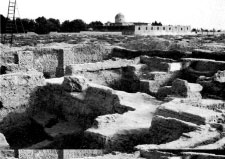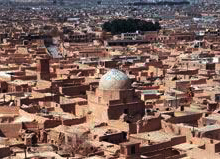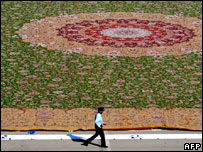|
Exploration of Forgotten Inscription of Xerxes in
Turkey
Soudabeh
Sadigh
foreigndesk@chn.ir


Tehran,
4 August 2007 (CHN Foreign Desk) – The first big achievement of
Iranian couple who have started their exploration tour around the world
with motor cycle, was finding the forgotten inscription of Xerxes, the
Achaemenid Emperor, in heights of Van Lake in Turkey.
While just less than two weeks has passed since the Iranian couple have
started their tour around the world, Mrs and Mr. Gheidi have sent a
number of invaluable gifts for their countrymen: pictures of Xerxes’s
inscription located next to Van Lake in Turkey which was somehow unknown
for a long time and no picture was taken from it until now.
Announcing this news, Gholamreza Ramezani, general manager of Iranians
Research Growth Institute, which is in charge of planning the project
of traveling around the world in 800 days for this couple, said: “One
of the main aims of this Iranian couple was to find the exact place
of this inscription in Van Lake.”
He further explained that, Dr. Razmjou, expert of Achaemenid history
and ancient Persian language attracted out attention towards this inscription,
he further said that the exact place of this inscription is not known.
“Apparently some 100 years ago a design from this inscription was
prepared through which experts of ancient languages started to translate
it. This inscription was decoded by Ronald G. Kent, linguist and expert
of old Persian language, for the first time in 1908. However, the efforts
of this Iranian couple led into identifying the exact location of this
inscription which was unknown until know,” added Ramezani.
According to Ramezani, two Iranian and Turkish guides helped Mrs. and
Mr. Gheidi upon their arrival to Turkey in this exploring trip. “Considering
the existence of a number of other inscriptions in Van area, the pictures
were emailed right away to a team of experts in Tehran to be studied
and comparing them with what they knew about Xerxes inscription in an
attempt to identify it,” said Ramezani.
______________________________________________
Number
16 Fortress of Gorgan’s Wall Discovered
Gorgan’s
Historic Wall

Third season of archeological excavations conducted by Iranian-British
joint team on Sassanid wall of Gorgan led to discovery of the no. 16
fortress of this historic defensive wall.
Tehran, 20 August 2007 (CHN Foreign Desk) – Continuation of geophysical
activities of Iranian-British joint archeology team on great wall of
Gorgan have resulted in discovery of the no. 16 fortress which is located
inside the vicinity of Gorgan’s wall.
Consisted of archeologists from Iran’s Cultural Heritage, Handicrafts,
and Tourism Organization (ICHHTO), and University of Edinburgh and Durham
University, joint Iranian-British archeology team have started their
excavations in the vicinity of great wall of Gorgan, otherwise known
as Gorgan’s defensive wall, in an attempt to find out more about
this stunning architectural masterpiece. Studies on this historic wall
originally started with the aim of finding the political and social
significance of the wall during the Parthian and Sassanid dynastic periods.
In order to clarifying the exact date of this historical fortress, recently
archeologists have started some sounding works in the area.
Regarding the architectural style of this newly discovered fortress,
Hamid Omrani, Iranian head of the archeology team explained that the
interior parts of the fortress were constructed symmetrical. “The
fortress is located in the interior space of the wall and while more
than 1700 years have passed since its construction, it has still remained
intact,” added Omrani.
Great wall extended for 200 kilometers in the southern coast of the
Caspian Sea, is the most ancient and the longest wall in Iran. It was
constructed to prevent invasions by the Heptai tribes from north side
of the country. Comparable to the Great Wall of China, Gorgan’s
Defensive Wall has a cultural-historic importance and brings into light
the rich civilization of northern regions of present-day Iran.
Iranian-British joint team has also succeeded in discovering the biggest
fortress, 64 hectares in area, in one kilometer distance outside of
Gorgan’s wall during the past few days. Recently, the extent of
the Great Wall of Gorgan was traced in the waters of the Caspian Sea,
buried in sediments.
______________________________________________
Iran’s
Earthenware Texture Waits for ICHHTO’s Decision

City
of Yazd is known as the biggest and most untamped adobe city in Iran
While less than 6 months has remained to the time for clarifying the
place for establishing an international research center for adobe architecture,
and despite that Iran is one of the main choices for establishing this
center, no measure has been done in this regard by Iranian authorities.
Tehran, 18 August 2007 (CHN Foreign Desk) – After four years since
representatives of ICCROM and ICOMOS have recognized Iran as the best
place for establishing an international research center for earthenware
architecture, at last authorities of Iran’s Cultural Heritage,
Handicrafts, and Tourism Organization (ICHHTO) have decided to hold
a meeting to see about it. This is while less than 6 months have remained
to the time for making a decision for clarifying a place for establishing
this center.
The idea for establishing an international research center for earthenware
architecture was came up during the 9th international conference on
the study and conservation of earthenware architecture which was held
in city of Yazd in 2003 which opened a new horizon for being hopeful
for preserving adobe architectural texture. In the conference, the ancient
city of Meybod in Yazd province was suggested as the best place for
establishing such a center due to it unique adobe architectural style.
This idea was greatly welcomed by Nicholas Stanley-Price, director general
of the International Center for the Study of the Preservation and Restoration
of Cultural Property (ICCROM), as well as Michael Petzel, president
of the International Council on Monument and Sites (ICOMOS). However,
the suggestion never came into force and after four years, Iranian authorities
have not taken any serious action in this regard. This is while only
6 months have remained to the time of the 10th international conference
which is going to be held in Mali in February 2008.
Experts believe that considering the existence of a large number of
earthenware constructions in Iran, establishing the international institute
of mud-brick studies, would guarantee the protecting this ancient heritage.
However, due to neglects in this regard, it is afraid that despite all
its potentials, Iran would lose the chance for being host of the first
international research center for earthenware structures and pass the
opportunity down to another country.
Although authorities of ICHHTO show solidarity for launching this center
in adobe city of Meybod, evidence indicate that no measure has been
done in this regard yet.
According to Isa Esfanjari, expert of ICHHTO provincial department in
Yazd, governor office of Yazd province and representative of Meybod
city in Iran’s parliament have expressed their readiness to support
this project. “The project is just waiting for endeavor of ICHHTO
to do something in this regard,” said Esganjari.
Regarding the attempts which have been made to attract the cooperation
of ICHHTO in this project, Azizolah Seifi, director of Cultural Heritage,
and Tourism Organization of Yazd province told CHN: “We have asked
for holding a session with attendance of Esfandiar Rahim Mashayi, president
of ICHHTO, and his deputy Hamid Baghayi to discuss the case in detail.”
The final decision would be made by ICHHTO after assessing all proposals.
Prior to this Meybod’s 60-year-old adobe structure, which was used
by British forces during World War II, was proposed as the venue for
the international institute of mud-brick studies. Meybod is the first
historic city which has been entirely registered in the list of Iran’s
National Heritage sites.
______________________________________________
CARPET
::.. Iran unveils the world's largest carpet

Iran
unveils vast handmade carpet
The
carpet was woven with cotton and wool from both Iran and New Zealand
Iran has unveiled what it says is the world's largest handmade carpet,
a vast green and red floor covering that is larger than a football pitch.
The
carpet, which took 1,200 weavers some 18 months to make, is destined
for a mosque in the United Arab Emirates .
Measuring
5,625 sq m (60,546 sq ft), the carpet was made in nine separate segments
with 2.2 billion knots.
It
was woven in Iran 's north-eastern province of Khorasan and is worth
an estimated $5.8m (£2.8m).
Half
of that sum is destined for the local area in Khorasan, where it was
produced using about 38 tons of wool and cotton.
The
nine sections of the carpet will be stitched together after being flown
to Abu Dhabi in two separate aeroplanes.
Four
groups of people would be sent to UAE for the fitting and cleaning of
the carpet, said Jalaleddin Bassam, the head of Iran 's state carpet
company.
He
said the carpet was an important commission for Iran 's carpet-making
industry, and said it could lead to further orders.
"
Iran is in talks to make similar carpets for Oman and other Gulf countries,"
he told Agence France-Presse.
The
carpet - mainly green, red and cream - was made using 25 different colours
of wool sourced from the town of Sirjan , in southern Iran , as well
as New Zealand .
______________________________________________
Billions
for arabs in Iraq and Syria, Iran's Hormozgan Historical Sites "Zero"
Aug 16, 2007
While 5 months have passed since Iranian new year, no budget has been
still allocated for researching programs and excavations in Hormozgan
historical sites. In a talk with CHN, Marjan Ravayi, expert of the Cultural
Heritage and Tourism Department of Hormozgan province, explained about
the interruption in researching projects of this province due to lack
of budget.
She further
added that since the condition for preserving historical sites after
being excavated is not prepared yet, the budget which has been considered
by Iran's Cultural Heritage, Handicrafts and Tourism Organization (ICHHTO)
for undertaking excavations in one of historical sites is actually unusable.
This is
while archeological excavations had been already started last year in
Hormozgan province which led into discovery of some important historical
evidence. The project was supposed to be resumed if the budget is provided.
Located
in southern Iran, Hormozgan province has 14 islands in the Persian Gulf
and 1000 kilometers of coastline. The province is known to have been
a settlement area during the Achaemenid dynastic era (550-330 BC). Hormozgan
is said to have been particularly prosperous between 241 and 211 BC,
but is said to have grown even further in trade and commercial significance
after the arrival of the Islamic era (651 AD).
Marco Polo
visited the port of Bandar Abbas, capital city of Hormozgan province
in 1272 and 1293 and reported widespread trading in Persian jewelry,
the ivory and silk of IndoChina, and pearls from Bahrain in the Bazaars
in the port of Hormuz.
Lashtan
fortress located 6 kilometers east of Lengeh port, which is believed
to date back to the Achaemenid era, is one of Hormozgan historical sites
which ICHHTO experts are trying to prepare its file for being inscribed
in list of UNESCO's World Heritage Sites.
© Iranian.ws
|


